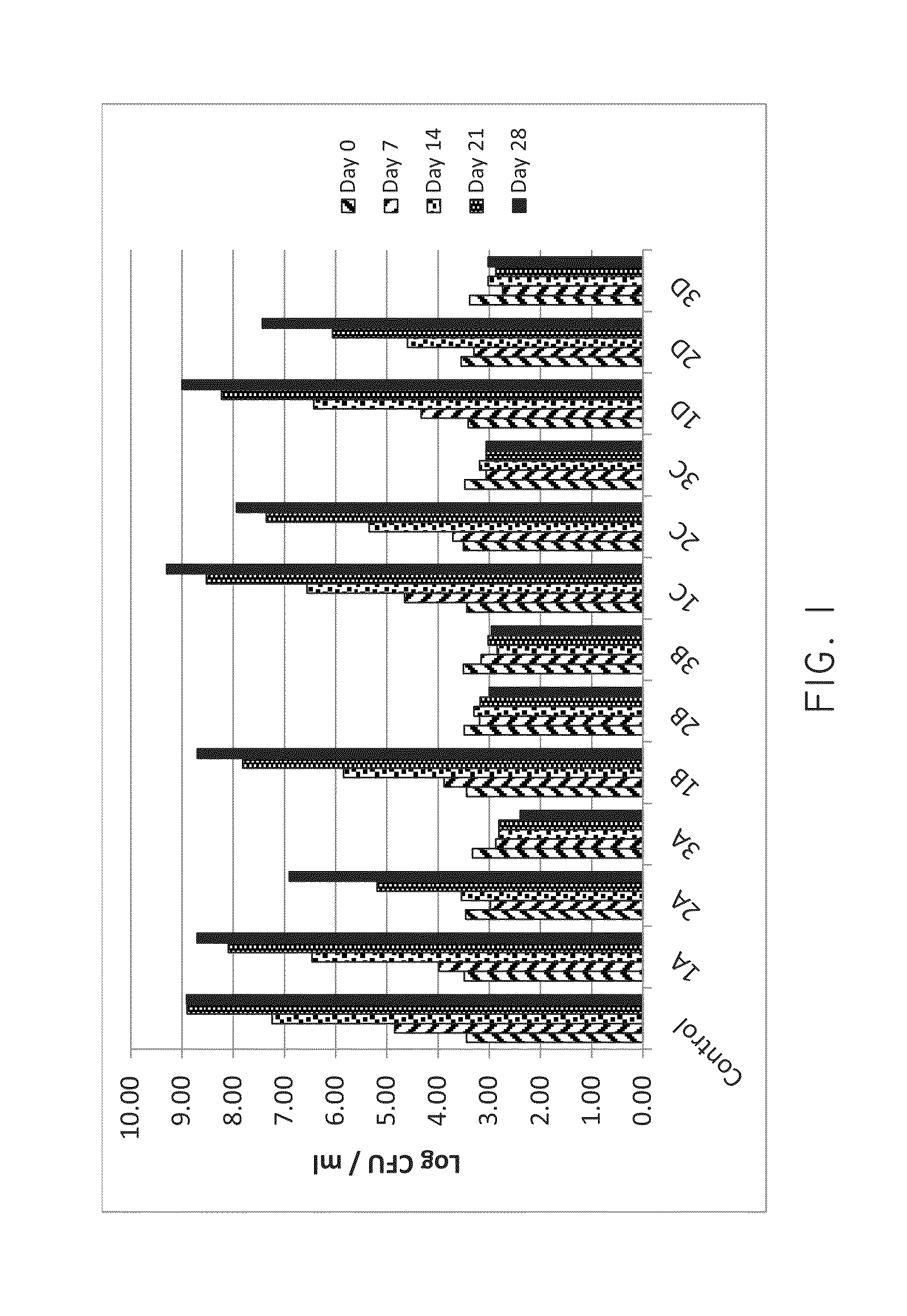Compositions and methods for control of listeria monocytogenes
a technology of listeria monocytogenes and compositions, applied in the field of food products, can solve the problems of listeriosis, a potentially lethal food-borne infection, and food borne illness remains an important public health problem, and achieves the effects of reducing the risk of foodborne illness
- Summary
- Abstract
- Description
- Claims
- Application Information
AI Technical Summary
Benefits of technology
Problems solved by technology
Method used
Image
Examples
example 1
Comparison of Various Compositions
[0055]Various antimicrobial compositions were prepared. Specifically, antimicrobial preservative compositions were prepared by combining potassium lactate, potassium diacetate, and potassium propionate, in a solvent of water at various concentrations as shown in Table 1 below.
TABLE 1Potassium LactatePotassiumPotassiumComposition(Wt. %)Diacetate (Wt. %)Propionate (Wt. %)A6000B5640C5280D48120E5604F5208G48012H5622I5244J4866K401010
[0056]Amounts of the test composition were diluted with BHI (brain heart infusion) broth in order to form the various concentrations as indicated in Table 2.
[0057]A standard inoculum was prepared consisting of a 5-strain culture of L. monocytogenes. A volume of the standard inoculum was added to the diluted antimicrobial compositions.
TABLE 2TestTotal Amount ofTotalSampleCompositionAntimicrobialAntimicrobialsIDUsedSolution UsedUsed (Solids)ControlNONENONENONE1AA6.25wt. %3.75wt. %2AA12.5wt. %7.5wt. %3AA25wt. %15wt. %1BB6.25wt. %...
example 2
Inhibition of L. Monocytogenes Growth on Scrapple
[0059]An antimicrobial preservative composition was prepared by combining potassium lactate, potassium diacetate, and potassium propionate, in a solvent of water. The final composition of the antimicrobial preservative composition was 40 wt. % potassium lactate, 10 wt. % potassium diacetate, and 10 wt. % potassium propionate. The pH of the antimicrobial solution was a pH of 5.0 or 5.5 (measured as a 3% dilution in deionized water).
[0060]Scrapple was prepared according to industry standards. However, prior to setting the mixture into molds, a test composition was added and homogenously blended into the mixture.
[0061]In the first trial, the scrapple was combined with the antimicrobial preservative composition in an amount equal to 1.5% weight percent of the scrapple (e.g., preservative solids at 0.9% weight percent of the food product). In the first trial, some of the scrapple preparations included a flavor masking agent and some did no...
example 3
Inhibition of L. Monocytogenes Growth on Hot Dogs
[0068]An antimicrobial preservative composition was prepared by combining potassium lactate, potassium diacetate, and potassium propionate, in a solvent of water. The final composition of the antimicrobial preservative composition was 40 wt. % potassium lactate, 10 wt. % potassium diacetate, and 10 wt. % potassium propionate. The pH of the antimicrobial solution was 5.5 (measured as a 3% dilution in deionized water).
[0069]Hot dogs were prepared according to industry standards. However, prior to extruding the hot dog batter (meat, curing agents, flavoring, etc.) into casings, a test composition was added and homogenously blended into the hot dog batter.
[0070]In the first treatment (A), the hot dog batter was combined with the antimicrobial preservative composition in an amount equal to 1.0% weight percent of the hot dog (i.e., preservative solids at 0.6% weight percent of the food product). In the first trial, some of the hot dog prepa...
PUM
| Property | Measurement | Unit |
|---|---|---|
| Fraction | aaaaa | aaaaa |
| Fraction | aaaaa | aaaaa |
| Time | aaaaa | aaaaa |
Abstract
Description
Claims
Application Information
 Login to View More
Login to View More - R&D
- Intellectual Property
- Life Sciences
- Materials
- Tech Scout
- Unparalleled Data Quality
- Higher Quality Content
- 60% Fewer Hallucinations
Browse by: Latest US Patents, China's latest patents, Technical Efficacy Thesaurus, Application Domain, Technology Topic, Popular Technical Reports.
© 2025 PatSnap. All rights reserved.Legal|Privacy policy|Modern Slavery Act Transparency Statement|Sitemap|About US| Contact US: help@patsnap.com



